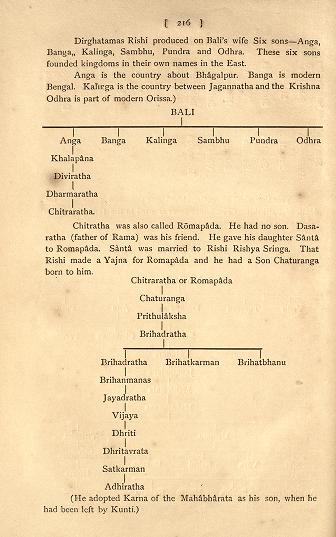
| ANG Ang
Desh was an ancient Indian kingdom that flourished on the eastern
Indian subcontinent and one of the sixteen mahajanpadas ("large
state").
Counted among the "sixteen great nations" in Buddhist texts like the Anguttar Nikaya, Ang also finds mention in the Jain Vyakhyaprajnapti’s list of ancient janpads. Some sources note that the Angs were grouped with people of ‘mixed origin’, generally in the later ages.
Etymology
:
Jat
clans :
Ancestry of Bali Bhagavat Puran provides us the ancestry of Bali. Bali was a king in line of Anu son of Yayati as under :
Yayati → Anu → Sabhanar → Kalanar → Janamejay → Maha Shal → Mahamanas → Titiksh → Rushadrath → Hom → Sutapas → Bali.
As per Bhagavat Puran the Dirghatama Rishi produced on Bali's wife six sons: Ang, Bang, Kaling, Sambhu, Pundra and Odhra.
Mention
by Panini :
Angka is a term mentioned by Panini in Ashtadhyayi.
Angi is a term mentioned by Panini in Ashtadhyayi.
History
:
Ang
Desh :
The first nomenclature of the Ang country is in the Atharv Ved 5,22,14 - 'Gandharibhyam Moojavadhyogebhyo Magadebhaya: Prayasana Janam Shevadhim Tavamanam Paridadamsi.' this
[p.2]: The non-violent statement indicates that till the creation (or post-Vedic period) of the Atharv Ved, the Ang, like Magadh, was outside the spread of Aryan civilization, which ranged from Punjab to Uttar Pradesh was Ang and Magadh were two parts of the same kingdom in the Mahabharat period. In Shanti Parv 29,35 (Angm Brihadratham Chaiv dead 'srnjaya shushrum'), Magadharaj Jarasandh 's father Brihadrath is the ruler of Ang. Shanti Parv 5,6-7 ('Pritya Dadou Karnai Malinin Nagaramath, Angeshu Narashardul S Rajasit Saptnajit. Palayamas Champancha Karna: Parbalardan:, Duryodhanasyanumate Tavapati Viditana and') is clear that Jarasandha gave Karna Angstha Malini or Champapuri there Was accepted as the king of. Then Duryodhan the equipment was declared Angraj.
In the Vedic period - adverse to the situation of the Vedic period, during the Mahabharat, the Ang came under the influence of the Aryan civilization and only one part of the Punjab - Madra - was considered excluded from the Arya culture at this time. According to the foundation of Angdesh was laid by King Ang. Probably Ang-Vairochan mentioned in Aitareya Brahman 8,22 was the founder of Angraj. It is known from the Jataka tales and other texts of Buddhism that Gautam Buddh. Prior to this, the organ was counted in the Shodash districts of Uttarbharat. The capital of Ang in this period was Champanagari. Angnagar or Champa is also mentioned in the Buddhist 27, 11. In the pre-Buddhist period there was always hostility to Ang and Magadh to the state. Jainasutra - In worship, there is a feeling of enmity with Magadh of Ang and its neighboring countries. The Pragyapana-sutra also mentions Ang along with other districts and Ang and Bang have been described as important places of Aryans. Magadh of the kings of Ang in their opulenceBut there was also authority as appears from the mention of Vidhurpanditjatak (Kavale 6, 133) in which the capital city of Magadh has been described as a city of Angdesh. But this situation did not take long to reverse and Bimbisar, the prince of Magadh killed Angraj Brahmadatt and annexed his kingdom to Magadh. Bimbisar had also been the ruler of Ang till his father's death.
In Jain texts, Kunik Ajatshatru, son of Bimbisara, is described as the king of Ang and Champa. In the Mauryan period, the Ang was definitely under the great empire of Magadh. Kalidas Raghu In 6,27, Angraj is mentioned in the context of Indumati-Swayamvar immediately after Magadh-Naresh, which suggests that Ang's reputation may have been somewhat lower than Magadh in the pre-Gupta period.
Raghu In 6, 27 itself, there is a fascinating description of trained elephants of Angraj - 'Jagad ChannamayamAngnath: SurAngnapratit Yauvanshree: Vinitnag: Kilsutarakararendran Padma underground The Vishnu Puran Part 4, Chapter 18 mentions the Angvan kings. The Kathasaritsagar 44, 9 indicates that in the eleventh century AD, the extension of Angdesh was to the seashore (Bay of Bengal) because one of the towns of Ang was situated on the banks of the Vittankpur sea.
There is an incident in the Mahabharat text that Acharya Drona organized a competition in Hastinapur to demonstrate the war skills of the Kaurav princes. Arjun emerged as the highest talented archer in this competition. Karna challenged Arjun to a duel battle in this competition. But Kripacharya turned down saying that Karna is not a prince. Therefore one cannot participate in this competition. Then Duryodhana declared Karna the king of Ang.
Karngarh
:
Aparn
:
Vijayendra Kumar Mathur has written ... Kekat (AS, p.192) was a
transitional state of Gaya (Bihar). According to the Purans, Buddhavatar
Kekat took place in the country itself. The first mention of Kikat
is in the Rigved - 'Kinte krirmantanti kiketeshu gavo nashiran duhe
na tapanati dharmaan aobharpramagandasya Vedo naichashkhan's madhvandrandhyana:'
3,53, 14. In this quotation Pramagand is mentioned. According to
Yask (Nirukta 6,32) Kikat was a non-Aryan country. Kekat was a name
of Magadh in the Purans and was generally considered unholy; Just
gone and Rajgrih was worshiped in the form of pilgrimage - 'Kiketeshu
Gaya Punya Punya Rajgriha Vanam' Vayu Puran 108,73.
Ang
in the Veds :
Based on Mahabharat evidence, the kingdom of the Angs roughly corresponded to the region of Bhagalpur and Monghyr in Bihar and parts of Bengal; later extended to include most of Bengal. River Champa (modern Chandan) formed the boundaries between the Magadh in the west and Ang in the east. Ang was bounded by river Koshi on the north. According to the Mahabharat, Duryodhan had named Karna the King of Ang.
In
Mahabharat :
Source :
https://www.jatland.com/ |
